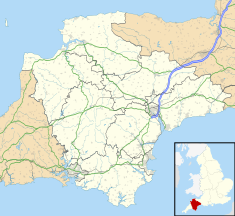Bideford Town Hall
| Bideford Town Hall | |
|---|---|
 Bideford Town Hall | |
| Location | Bideford |
| Coordinates | 51°01′00″N 4°12′18″W / 51.0167°N 4.2050°WCoordinates: 51°01′00″N 4°12′18″W / 51.0167°N 4.2050°W |
| Built | 1851 |
| Architect | Richard Davie Gould and Alfred Dunn |
| Architectural style(s) | Elizabethan style |
Listed Building – Grade II | |
| Official name | Town Hall and Public Library |
| Designated | 19 March 1973 |
| Reference no. | 1200934 |
 Shown in Devon | |
Bideford Town Hall is a municipal building at the corner of Bridge Street and New Road in Bideford, Devon, England. The building, which is the meeting place of Bideford Town Council, is a Grade II listed building.[1]
History[]
A medieval town hall in Bideford was the venue for the "court of inquisition" on 3 July 1682 into the activities of Temperance Lloyd, Susannah Edwards and Mary Trembles, who were all hanged on 25 August 1682, the last three women to be executed for witchcraft in England.[2][3] A second town hall in the town, which accommodated cells in the basement for both criminals and debtors, was completed in 1698.[4][5] In the early 19th century the local borough council met in the old Bridge Hall on the north side of Bridge Street, which had been rebuilt in 1758.[6][7]
The current town hall building was designed by Richard Davie Gould in the Elizabethan style and officially opened in 1851.[8] The original design involved an asymmetrical main frontage with four bays facing onto Bridge Street (the right hand section of the current structure); it featured an arched doorway in the left hand bay and Tudor style windows in the other bays, flanked by full-height buttresses, with mullion windows on the first floor and crenelation above.[1] The corner of Bridge Street and Church Walk was canted and featured a coat of arms with a turret above.[1] Internally, the principal room was the courtroom on the first floor.[1] Meanwhile, Bridge Hall was replaced with Bridge Buildings, which featured a sundial inscribed with the words, "The Sun to us the sign gives", in 1882.[9]
Following the demolition in July 1904 of Thomas Hogg's chemist's shop, which had dated back to the early 19th century and had stood on the corner of New Road and Bridge Street,[10] the town hall was extended along New Road by H. Glover and Sons of Bideford to a design by Alfred Dunn in a similar style to the original town hall in 1905.[1] The left section of the extension involved a four-bay public library; the centre section involved a tower with an entrance to the library on the ground floor and a turret above and the right hand section, referred to as the "municipal buildings", featured a large oriel window on the first floor.[1] The corner of New Road and Bridge Street was also canted and featured a balcony on the first floor with a coat of arms and turret above.[1] The extension also created an extra two bays on the Bridge Street elevation (the left hand section of the current structure).[1] A plaque was placed on this section to commemorate the lives of the three women who had been executed for witchcraft.[11] Internally, the principal room in the extension was the council chamber.[1]
Three carved shields bearing the arms, which had been granted to the Bideford Borough Council, were fixed to the Bridge Street elevation of the town hall in April 1937.[12] The town hall continued to serve as the headquarters of Bideford Borough Council but ceased to be the local seat of government when the enlarged Torridge District Council was formed in 1974.[13] It subsequently became the meeting place of Bideford Town Council.[14]
Works of art in the own hall include a portrait by Edmund Dyer of Admiral Sir Richard Grenville, who died in command of Revenge at the Battle of Flores in August 1591 during the Anglo-Spanish War,[15] and a portrait by George Romney of George Stucley Buck, who was the father of Lewis William Buck MP.[16]
References[]
- ^ a b c d e f g h i Historic England. "Town Hall and Public Library (1200934)". National Heritage List for England. Retrieved 8 December 2020.
- ^ Barry, J. (2012). Witchcraft and Demonology in South-West England, 1640-1789. Palgrave Macmillan. p. 61. ISBN 978-1349332304.
- ^ Semmens, Jason; Paynter, William H. (2016). Cornish Witchcraft. Jason Semmens. p. 115. ISBN 978-0954683931.
- ^ Lysons, Daniel; Lysons, Samuel (1822). "'Parishes: Bickton - Bridford', in Magna Britannia: Volume 6, Devonshire". London: British History Online. pp. 47–69. Retrieved 8 December 2020.
- ^ Rogers, Inkerman (1938). A Concise History of Bideford (PDF). Gazette Office. p. 23.
- ^ Rogers, p. 27
- ^ "Bideford Heritage Trail". Visit Bideford. Retrieved 8 December 2020.
- ^ "New Town Hall, at Bideford, England, 1851". London: Civil Engineer & Architect's Journal. 4 October 1851. p. 524. Retrieved 8 December 2020.
- ^ Rogers, p. 35
- ^ "Times Past: From chemist shop to Bideford Town Hall". North Devon Gazette. 23 August 2020. Retrieved 8 December 2020.
- ^ Rogers, p. 21
- ^ Rogers, p. 40
- ^ Local Government Act 1972. 1972 c.70. The Stationery Office Ltd. 1997. ISBN 0-10-547072-4.
- ^ "Annual Report 2019" (PDF). Bideford Town Council. Retrieved 8 December 2020.
- ^ Dyer, Edmund. "Sir Richard Grenville (1542–1591)". Art UK. Retrieved 8 December 2020.
- ^ Romney, George. "George Stucley Buck". Art UK. Retrieved 8 December 2020.
- Government buildings completed in 1851
- City and town halls in Devon
- Grade II listed buildings in Devon
- Buildings and structures in Bideford
